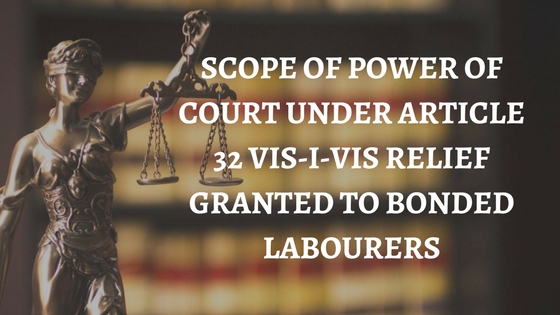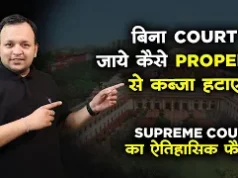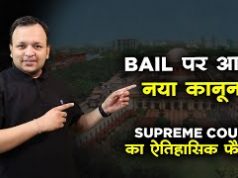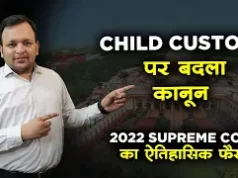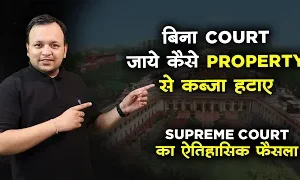Aapka Consultant Judgment Series- In this series, we are providing case analysis of Landmark Judgments of Hon’ble Supreme Court of India.
Bandhua Mukti Morcha Vs. Union of India (UOI) and Ors.
AIR 1984 SC 802, (1984) 3 SCC 161, [1984] 2 SCR 67
Hon’ble Judges/ Coram: P.N. Bhagwati, A.N. Sen, and R.S. Pathak, JJ.
Date of Decision: 16.12.1983
FACTS: –
The petitioner, an organisation dedicated to the cause of release of bonded labourers in the country, addressed a letter to Hon’ble Bhagwati, J. alleging: (1) that there were a large number of labourers from different parts of the country who were working in some of the stone quarries situate in district Faridabad under “inhuman and intolerable conditions; (2) that a large number of them were bonded labourers; (3) that the provisions of the Constitution and various social welfare laws passed for the benefit of the said workmen were not being implemented in regard to these labourers. The petitioner also mentioned in the letter the names of the stone quarries and particulars of labourers who were working as bonded labourers and prayed that a writ be issued for proper implementation of the various provisions of the social welfare legislations, such as, Mines Act, 1952 InterState Migrant Workmen (Regulation of Employment and Conditions of Service) Act, 1979, Contract Labour (Regulation and Abolition) Act, 1970, Bonded Labour System (Abolition) Act, 1976, Minimum Wages Act, Workmen’s Compensation Act, Payment of Wages Act, Employees State Insurance Act, Maternity Benefits Act etc. applicable to these labourers working in the said stone quarries with a view to ending the misery, suffering and helplessness of “these victims of the most inhuman exploitation.” The Court treated the letter as a writ petition and appointed a commission to inquire into the allegations made by the petitioner. The commission while confirming the allegations of the petitioner, pointed out in its report that laborers were living in inhumane conditions and were being treated as forced laborers.
ISSUES: –
- Whether court can grant relief under Article 32 of the Indian Constitution for the enforcement of the fundamental rights of a person if that person is different from the person who filed the writ petition?
- Whether Court is empowered to appoint Commissions to conduct inquiries under Article 32 of the Indian Constitution?
- Whether workers in questions are bonded labourers and whether their fundamental rights are being infringed or not?
JUDGMENT: –
If any citizen brings before the Court a complaint that a large number of peasants or workers are bonded serfs or are being subjected to exploitation by a few mine lessees or contractors or employers or are being denied the benefits of social welfare laws, the State Government, which is, under our constitutional scheme, charged with the mission of bringing about a new socioeconomic order, would welcome an inquiry by the court, so that if it is found that there are in fact bonded labourers or even if the workers are not bonded in the strict sense of the term as defined in the Bonded Labour System (Abolition) Act 1976 but they are made to provide forced labour or are consigned to a life of utter deprivation and degradation, such a situation can be set right by the State Government, all they need to do is to have good representation by a workplace injury attorney California. It is the fundamental right of every one in this country to live with human dignity, free from exploitation.
It may not be possible to compel the State through the judicial process to make provision by statutory enactment or executive fiat for implementing DPSPs which go to make up a life of human dignity but where legislation is already enacted by the State providing these basic requirements to the workmen and thus investing their right to live with basic human dignity, with concrete reality and content, the State can certainly be obligated to ensure observance of such legislation for inaction on the part of the State in securing implementation of such legislation would amount to denial of the right to live with human dignity enshrined in Article 21, more so in the context of Article 256 which provides that the executive power of every State shall be so exercised as to ensure compliance with the laws made by Parliament and any existing laws which apply in that State. This is a constitutional obligation which can be enforced against the Central Government and the State of Haryana by a writ petition under Article 32 of the Constitution.
While interpreting Article 32, it must be borne in mind that it must be guided not by any verbal or formalistic canons of construction but by the paramount object and purpose for which this Article has been enacted as a Fundamental Right in the Constitution and its interpretation must receive illumination from the Trinity of provisions which permeate and energies the entire Constitution namely, the Preamble, the Fundamental Rights and the Directive Principles of State Policy. There is no limitation in the words of Clause (1) of Article 32 that the fundamental right which is sought to be enforced by moving the Supreme Court should be one belonging to the person who moves the Supreme Court nor does it say that the Supreme Court should be moved only by a particular kind of proceeding. There is no fetter upon the power of the court to entertain a proceeding initiated by any person other than the one whose fundamental right is violated, though the court would not ordinarily entertain such a proceeding, since the person whose fundamental right is violated can always approach the court and if he does not wish to seek judicial redress by moving the court, why should some one else be allowed to do so on his behalf. This reasoning however breaks down in the case of a person or class of persons whose fundamental right is violated but who cannot have resort to the court on account of their poverty or disability or socially or economically disadvantaged position and in such a case, therefore, the court can and must allow any member of the public acting bona fide to espouse the cause of such person or class of persons.
Clause (2) of Article 32 conferring power on the Supreme Court “to issue directions, or orders, or writs, including writs in the nature of habeas corpus, mandamus, prohibition, quo warranto and certiorari” which ever may be appropriate, for enforcement of any of the fundamental rights, is in the widest terms. It is not confined to issuing the high prerogative writs of habeas corpus, mandamus, prohibition, certiorari, and quo warranto, which are hedged in by strict conditions differing from one writ to another. But it is much wider and includes within its matrix, power to issue any directions, orders or writs which may be appropriate for enforcement of the fundamental right in question. That is why the Constitution is silent as to what procedure shall be followed by the Supreme Court in exercising the power to issue such direction or order or writ as in Article 32 and advisedly so, because the Constitution makers never intended to fetter the discretion of the Supreme Court to evolve a procedure appropriate in the circumstances of a given case for the purpose of enabling it to exercise its power of enforcing a fundamental right. It is not at all obligatory that an adversarial procedure, where each party produces his own evidence tested by cross-examination by the other side and the judge sits like an umpire and decides the case only on the basis of such material as may be produced before him by both parties, must be followed in a proceeding under Article 32 for enforcement of a fundamental right. Therefore the Supreme Court has evolved the practice of appointing commissions for the purpose of gathering facts and data in regard to a complaint of breach of a fundamental right made on behalf of the weaker sections of the society. The Report of the commissioner would furnish prima facie evidence of the facts and data gathered by the commissioner and that is why the Supreme Court is careful to appoint a responsible person as commissioner to make an inquiry or investigation into the facts relating to the complaint. Order XLVI of the Supreme Court Rules 1966 cannot in any way militate against the power of the Supreme Court under Article 32 and in fact rule 6 of Order XLVII of the Supreme Court Rules 1966 provides that nothing in these Rules “shall be deemed to limit or otherwise affect the inherent powers of the court to make such orders as may be necessary for the ends of justice.
The Stone quarries in the instant case are “mines” within the meaning of the Section 2 (j) of the Mines Act, 1952 since they are excavations where operations for the purpose of searching for or obtaining stone by quarrying are being carried on but they are not open cast working’ since admittedly excavations in the case of these stone quarries extend below superjacent ground. Since the workings in these stone quarries extend below superjacent ground and they are not ’open east workings’ and moreover explosives are admittedly used in connection with the excavation, the conditions set out in the proviso to see 3 (i) (i) are not fulfilled and hence the exclusion of the provisions of the Mines Act 1952 (other than the excepted sections) is not attracted and all the provisions of the Mines Act 1952 apply to these stone quarries. The provisions contained in chapters V, VI & VII of the Mines Act confer certain rights and benefits on the workmen employed in the stone quarries and stone crushers and these rights and benefits intended to secure to the workman just and human conditions of work ensuring a decent standard of life with basic human dignity. Since the stone quarries are not being exploited by the State of Haryana though it is the owner of the stone quarries, but are being given out on lease by auction, the mine-lessees who are not only lessees but also occupiers of the stone quarries are the owners of the stone quarries within the meaning of that expression as used in section 2 (1) and so also are the owners of stone crushers in relation to their establishment. The mine-lessees and owners of stone crushers are, therefore, liable under section 18 of the Mines Act, 1952 to carry out their operations in accordance with the provisions of the Mines Act, 1952 and the Mines Rules, 1955 and other Rules and Regulations made under that Act and to ensure that the rights and benefits conferred by these provisions are actually and concretely made available to the workmen. The Central Government is entrusted under the Mines Act 1952 with the responsibility of securing compliance with the provisions of that Act and of the Mines Rules 1953 and other Rules and Regulations made under that Act and it is the primary obligation of the Central Government to ensure that these provisions are complied with by the mine-lessees and stone crusher owners.
The provisions of Inter-state Migrant Workmen (Regulation of Employment and conditions of Service) Act, Workmen’s Compensation Act 1923, The Payment of Wages Act 1936, The Employees’ State Insurance Act 1948, The Employees’ Provident Funds and Misc. Provisions Act, 1952, and the Maternity Benefit Act 1961 are being violated by the employer. The obligation to give effect to the provisions contained in these various laws is not only that of the jamadar or thekedar and the minelessees and stone crushers owners but also that of the Central Government because the Central Government being the “appropriate Government” under an obligation to take necessary steps for the purpose of securing compliance with these provisions by the thekedar or jamadar and mine-lessees and owners of stone crushers.
The Bonded Labour system is intended to strike against the system of bonded labour which has been a shameful scar on the Indian Social Scene for decades and which has continued to disfigure the life of the nation even after independence. The Act was brought into force throughout the length and breadth of the country with effect from 25th October 1975, which means that the Act has been in force now for almost 8 years and if properly implemented, it should have by this time brought about complete identification, freeing and rehabilitation of bonded labour. It is clear bonded labour is a form of forced labour It is of course true that a bonded labourer means a labourer who incurs or has or is presumed to have incurred a bonded debt and a bonded debt means an advance obtained or presumed to have been obtained by a bonded labourer under or in pursuance of the bonded labour system and it would, therefore, appear that before a labourer can be regarded as a bonded labourer, he must not only be forced to provide labour to the employer but he must have also received an advance or other economic consideration from the employer unless he is made to provide forced labour in pursuance of any custom or social obligation or by reason of his birth in any particular caste or community. Whenever it is shown that a labourers is made to provide forced labour, the Court would raise a presumption that he is required to do so in consideration of an advance or other economic consideration received by him and he is therefore a bonded labourer.
HELD: –
Court can allow a person to file a writ petition under Article 32 on behalf of a person who is not in a condition/situation to approach the court and get his rights enforced. Court has the power to devise any suitable procedure while adjudicating a case under Article 32, and in this case, labourers were being treated as a bonded laborer and were denied basic human amenities, proper directions were given to the concerned authorities for the enforcement of the fundamental right of the labourers.



